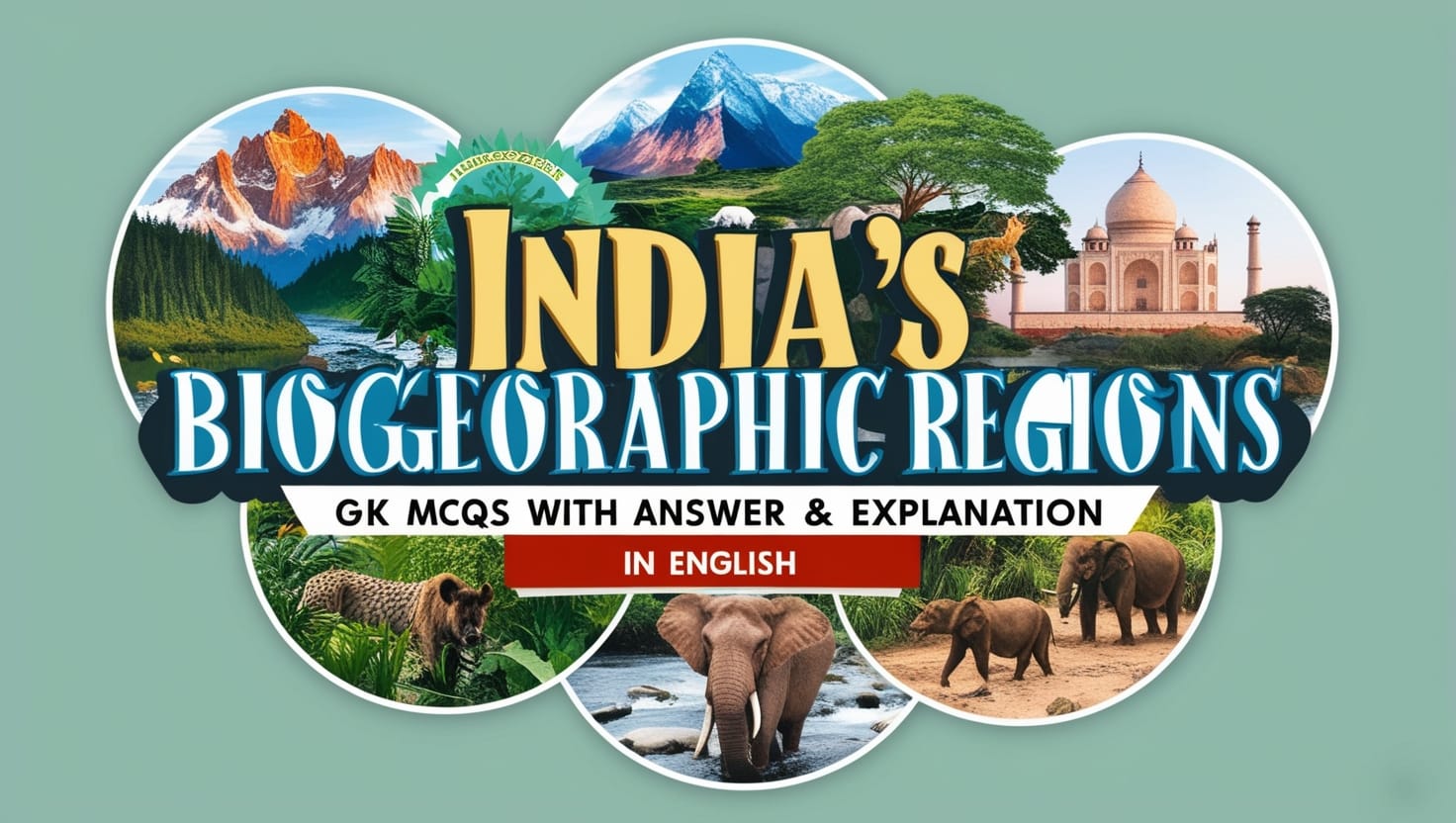
India’s Biogeographic Regions GK MCQs With Answer & Explanation in English offers a comprehensive and engaging way to explore the diverse biogeographic regions of India. This article provides a curated collection of multiple-choice questions (MCQs) designed to enhance your knowledge of India’s unique ecological zones, from the Himalayan mountains to the coastal plains.
Each question is accompanied by detailed answers and explanations to help you understand and retain the information effectively. Perfect for students, competitive exam aspirants, or anyone passionate about India’s natural heritage!
1. How many number of the Biogeographic zones are present in India?
- 4
- 8
- 10
- 15
Show Answer
Answer: 10
10 Biogeographic zones are Trans Himalayan zone, Himalayan zone, Desert zone, Semiarid zone, Western ghat zone, Deccan plateau zone, Gangetic plain zone, North east zone, Coastal zone and Islands present near the shore line.
2. The Andaman and Nicobar Islands are submerged parts of mountain range called:
- Arakan Yoma
- Pegu Yoma
- Askai Chin
- Tien Shan
Show Answer
Answer: Arakan Yoma
Arakan Yoma is a mountain range located in Southeast Asia. It runs parallel to the western coastline of Myanmar (Burma) and stretches into the eastern part of India. This mountain range plays a significant role in shaping the climate, vegetation, and biodiversity of the region, particularly in the northeastern states of India.
3. Thar desert lies in which among the following states of India?
1. Rajasthan
2. Gujarat
3. Punjab
4. Haryana
Choose the correct option from the codes given below:
- 1 & 2
- 1 & 3
- 1, 2 & 4
- 1, 2, 3 & 4
Show Answer
Answer: 1, 2, 3 & 4
The Thar Desert, also known as the Great Indian Desert, is a vast arid region located in the northwestern part of the Indian subcontinent. It covers parts of Rajasthan, Gujarat, Punjab, and Haryana in India, as well as portions of Pakistan. The Thar Desert is characterized by its harsh desert climate, low rainfall, extreme temperature variations, and unique flora and fauna adapted to arid conditions.
4. What is the rank of Thar desert in the world as per the total area coverage?
- 7th
- 11th
- 13th
- 17th
Show Answer
Answer: 17th
As per the total area, Thar desert ranked 17th in the world and ranked 9th in the subtropical desert category.
5. Which of the following is true about Estuary?
- It is the ecosystem marked by the mixing of sea water and river water
- They are always marked by very low salinity
- Both
- None
Show Answer
Answer: It is the ecosystem marked by the mixing of sea water and river water
An estuary is a unique ecosystem formed at the interface of freshwater rivers and saltwater bodies, such as seas or oceans. It is a semi-closed coastal area with a mix of marine and fresh water, resulting in a range of salinity levels. Estuaries are ecologically important as they serve as nurseries for many marine species, support diverse habitats, and play a vital role in nutrient cycling.
6. The Thar desert is situated in which among the following countries?
1. India
2. Pakistan
3. Afghanistan
Select the correct code from the options given below:
- Only 1
- Only 1 & 2
- Only 1 & 3
- 1, 2 & 3
Show Answer
Answer: Only 1 & 2
The Thar Desert is also known as The Great Indian Desert. It is a large arid region in the northwestern part of the Indian subcontinent that covers an area of 200,000 square kilometres. It forms a natural boundary between India and Pakistan. It is the world’s 17th largest desert.
7. Which of the following are the characteristic features of Thar desert?
1. The climate is characterised by excessive drought as the rainfall being scanty and irregular.
2. The relative humidity of the atmosphere is always high.
3. There are extreme variations of temperature and the temperature is frequently below freezing point at night.
Select the correct option from the codes given below:
- Only 1 & 2
- Only 1 & 3
- Only 2 & 3
- 1, 2 & 3
Show Answer
Answer: Only 1 & 3
Some of the characteristic features of Thar desert are as follows: 1. The climate is characterised by excessive drought as the rainfall being scanty and irregular. 2. The relative humidity of the atmosphere is always low. 3. There are extreme variations of temperature and the temperature is frequently below freezing point at night.
8. Which of the following statements are correct regarding Thar desert?
1. Thar desert is located to the north-west of the Aravali hills.
2. It covers Western Rajasthan and extends to the adjacent parts of Pakistan also.
3. Thar desert is also called the Marusthali.
Select the correct option from the codes given below:
- Only 1 & 2
- Only 2 & 3
- Only 1 & 3
- 1, 2 & 3
Show Answer
Answer: 1, 2 & 3
Thar desert is located to the north-west of the Aravali hills. It covers Western Rajasthan and extends to the adjacent parts of Pakistan also. Thar desert is also called the Marusthali.
9. Which of the following species are found in cold desert region?
1. Asiatic Ibex
2. Lion Tailed Macaque
3. Black Necked Crane
4. Snow Leopard
Select the correct option from the codes given below:
- Only 1, 2 & 3
- Only 2, 3 & 4
- Only 1, 3 & 4
- 1, 2, 3 & 4
Show Answer
Answer: Only 1, 3 & 4
Cold deserts are ecosystems characterized by arid conditions and low temperatures. Species adapted to these cold desert environments include wildlife such as the Asiatic Ibex, Black Necked Crane, Snow Leopard, Wild Yak, Tibetan Gazelle, Woolly Hare, and Tibetan Wild Ass. These species have unique adaptations to survive in extreme cold and arid climates.
10. Arrange the following places with respect to the richness in species diversity:
1. Gulf of Kachchh
2. Lakshadweep Islands
3. Andaman and Nicobar Islands
4. Gulf of Mannar
Select the correct option from the codes given below:
- 1, 2, 3, 4
- 2, 3, 1, 4
- 3, 2, 4, 1
- 3, 4, 2, 1
Show Answer
Answer: 3, 2, 4, 1
Among the four major reef areas found in India, the Andaman and Nicobar Islands are found to be very rich in species diversity followed by the Lakshadweep Islands, the Gulf of Mannar, and finally the Gulf of Kachchh.








Leave a Reply